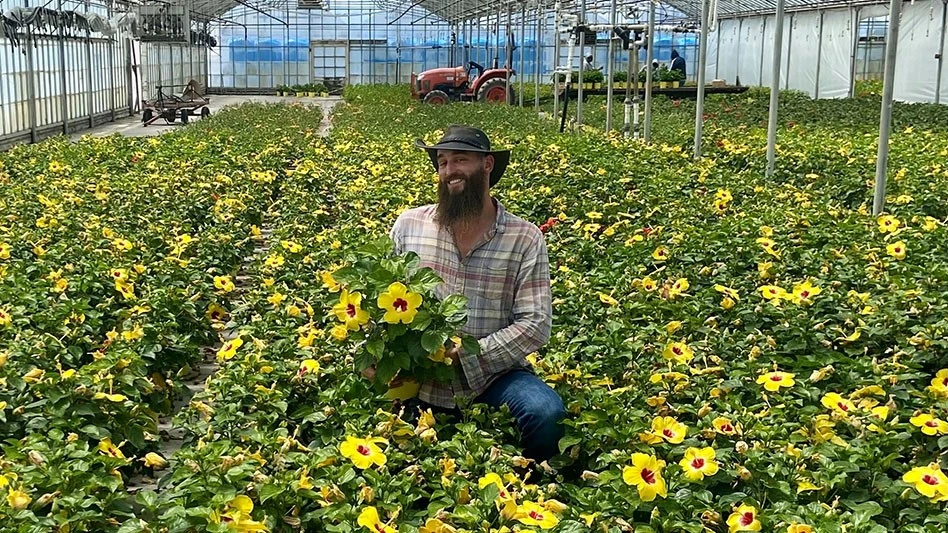

Whether he’s driving across the country for a new career or taking over 200 acres of production at Altman Plants, Joe Cunliffe isn’t afraid of adventure.
After finding horticulture in college, Cunliffe found his calling in an industry that offers steady challenges with no chance for boredom.
“The thing I enjoy most about this job is that it’s something different every day,” Cunliffe says. “I get bored easily, but in an industry like this, I’m never bored. I love the interactive, hands-on problem solving that I have to do every single day.”
Here’s how he’s applying his knowledge to enhance production at Altman.
Cultivating a career
Cunliffe discovered horticulture at the University of Georgia when he, in his words, “stumbled upon” the classes. As an avid camper and outdoorsman, he was drawn to the idea of working outside. After taking four years of horticulture classes in his home state, Cunliffe packed up his car and headed west, where he landed an internship at Smith Gardens in Marysville, Washington.
The internship turned into a job offer for section grower, and a couple years later, an assistant head grower role at Smith Gardens’ facility in Aurora, Oregon. In that position, Cunliffe helped the company expand and automate its production.
“We ended up adding an additional 20 acres of top-of-the-line greenhouses. We also retrofitted all of our old houses, installing booms and flood floors in every bay,” he says. “It definitely impacted our efficiency and gave the growers more tools to reach their full potential.”
In addition to overhauling the facilities, Smith also taught Cunliffe the importance of cultivating a strong team. He learned that being a successful grower is “not just figuring out what kind of fertilizers different plants need, but also what kind of leadership people need,” he says.

Communicating consistently
In early 2021, after eight years at Smith, Cunliffe made another move to Altman Plants in Salinas, California, where he serves as head grower. In this role, he oversees 100 acres of field and 100 acres of greenhouse/cold-frame production, growing annuals, perennials, hydrangeas, poinsettias and cyclamen. Additionally, the facility produces a “Smart Planet” drought-tolerant line featuring tropicals and plants native to California.
At Altman, Cunliffe is responsible for a much larger production space and a much bigger team. He currently manages seven section growers, who each control between 20 to 40 acres and teams of up to 60 laborers, for a total of 230 employees at peak. Comparatively, at Smith, his close-knit team consisted of about 25 people.
The key to managing a team 10 times larger than his last one is consistent communication.
“We have meetings at the same time every week with the growers, and I walk the greenhouse with the same grower at the same time on the same day every week,” Cunliffe says. “That consistency really helps them be more successful.”
When Cunliffe joined Altman, the morning huddles had stopped due to COVID concerns. One of his first priorities was reinstituting those meetings to maintain regular channels of communication between department heads.
“This is where everyone has an opportunity to speak so we can work out our issues together,” he says. “If we were on a 10-acre farm, I could probably dictate everything that should happen, but that’s really not possible across 200 acres. As head grower, I would be useless without the support of all these other people, so it’s really necessary to have good communication.”
Targeting the team’s talents
Although Altman’s Salinas facility is “a fairly traditional farm using a lot of traditional chemistries,” Cunliffe is starting to take a closer look at the growing program. Rather than just following the same processes out of habit, he’s taking a targeted approach to make the best use of his team’s resources.
“When I started, we were doing preventative drenches on all of our crops when we planted them,” he says. “I decided that drenching 200 acres by hand was way too much labor and too many chemicals, so we ended up cutting 90 percent of our preventative drenches without any negative effects. Now, we’ve been focusing on making sure that we only do applications when we need to.”
To that end, Cunliffe is working closely with one of his workers to develop a targeted scouting program instead of just spraying for pests routinely. Involving his team in this initiative will be key to its success.
“If I came up with the scouting program myself and tried to force it on other people, they’d be less likely to take it on,” he says. “But if they’re the ones creating it themselves, with support and guidance from me, they’re much more likely to own it.”
By helping his team utilize their skills more effectively and efficiently, Cunliffe is helping Altman grow.
“It really doesn’t matter how smart you are, how much experience you have, or how good of a grower you are,” he says. “If you have people on your side willing to work with you, you don’t need to know everything. If people feel respected, they’re going to put their knowledge and skills to better use.”

Explore the September 2022 Issue
Check out more from this issue and find your next story to read.
Latest from Greenhouse Management
- Anthura acquires Bromelia assets from Corn. Bak in Netherlands
- Top 10 stories for National Poinsettia Day
- Langendoen Mechanical hosts open house to showcase new greenhouse build
- Conor Foy joins EHR's national sales team
- Pantone announces its 2026 Color of the Year
- Syngenta granted federal registration for Trefinti nematicide/fungicide in ornamental market
- A legacy of influence
- HILA 2025 video highlights: John Gaydos of Proven Winners





